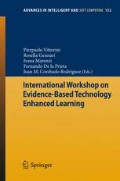Abstract
The role of temporal and causal connectives is relevant in reading comprehension. Children with comprehension difficulties have problems in interpreting these connectives (e.g. Amidon, 1976; Feagans, 1980; Pyykkônen, Niemi and Järvikivi, 2003; Trosborg, 1982). The Adaptive Learning System (ALS) TERENCE aims to develop children’s comprehension through the use of adaptive visual and verbal games. Within this framework, the purpose of this study was to assess connective comprehension with three visual and verbal tasks. Two hundred and eight English and Italian children participated in this study. The main results show that the use of pictures does not always support comprehension. Moreover, less skilled children perform better at simultaneous connective “while” compared to the temporal sequential connectives (before, after) and causal (because) ones.
Access this chapter
Tax calculation will be finalised at checkout
Purchases are for personal use only
Preview
Unable to display preview. Download preview PDF.
References
Ainsworth, S.: DeFT: A conceptual framework for considering learning with multiple representations. Learning and Instruction 16, 183–198 (2006)
Amidon, A.: Children’s understanding of sentences with contingent relations: Why are temporal and conditional connectives so difficult. Journal of Experimental Child Psychology 22, 423–437 (1976)
Andersson, A., Garrod, S.C., Sanford, A.J.: The accessibility of pronominal antecedents as a function of episode shifts in narrative text. Quarterly Journal of Experimental Psychology 35A, 427–440 (1983)
Anglin, G.J., Vaez, H., Cunningham, K.L.: Visual Representations and Learning: The Role of Static and Animated Graphics. In: Jonassen, D.H. (ed.) Handbook of Research for Educational Communications and Technology, pp. 865–913. Simon & Schuster, NY (2004)
Arfé, B., Di Mascio, T., Gennari, R.: Representations of Contemporaneous Events of a Story for Novice Readers. In: Magnani, L., Carnielli, W., Pizzi, C. (eds.) Model-Based Reasoning in Science and Technology. SCI, vol. 314, pp. 589–605. Springer, Heidelberg (2010)
Cain, K., Nash, H.: The influence of connectives on young readers processing and comprehension of text. Journal of Educational Psychology 103, 429–441 (2011)
Cain, K., Oakhill, J.: Profiles of children with specific reading comprehension difficulties. British Journal of Educational Psychology 76, 683–696 (2006)
Cain, K., Patson, N., Andrews, L.: Age- and ability-related differences in young readers’ use of conjunctions. Journal of Child Language 32, 877–892 (2005)
Clark, R.C., Lyons, C.: Graphics for Learning: Proven Guidelines for Planning, Designing, and Evaluating Visuals in Training Materials. Pfeiffer, CA (2004)
Claus, B., Kelter, S.: Comprehending narratives containing flashbacks: Evidence for temporally organized representations. Journal of Experimental Psychology: Learning, Memory, and Cognition 32, 1031–1044 (2006)
Cornoldi, C., Colpo, G.: Nuove Prove di Lettura MT per la Scuola Media Inferiore. Organizzazioni Speciali, Firenze (1995)
Feagans, L.: Children’s understanding of some temporal terms denoting order, duration, and simultaneity. Journal of Psycholinguistic Research 9, 41–56 (1980)
Gennari, S.P.: Temporal references and temporal relations in sentence comprehension. J. Exp. Psychol. Learn. Mem. Cogn. 30, 877–890 (2004)
Hegarty, M.: Mental animation: Inferring motion from static displays of mechanical systems. J. Exp. Psychol. Learn. Mem. Cogn. 18, 1084–1102 (1992)
Larkin, J.H., Simon, H.A.: Why a diagram is (sometimes) worth ten thousand words. Cognitive Science 11, 65–99 (1987)
Mandler, J.M.: On the comprehension of temporal order. Language and Cognitive Processes 1, 309–320 (1986)
Mayer, R.E.: Multimedia learning. Cambridge University Press, New York (2005)
Neale, M.D.: The Neale analysis of reading ability—Revised British edition. NFER-Nelson, Windsor (1989)
Pyykkönen, P., Niemi, J., Järvikivi, J.: Sentence structure, temporal order and linearity: Slow emergence of adult-like syntactic performance in Finnish. SKY Journal of Linguistic 16, 113–138 (2003)
Radvansky, G.A., Zwaan, R.A., Federico, T., Franklin, N.: Retrieval from temporally organized situation models. J. Exp. Psychol. Learn. Mem. Cogn. 24, 1224–1237 (1998)
Scaife, M., Rogers, Y.: External cognition: How do graphical representations work? International Journal of Human-Computer Studies 45, 185–213 (1996)
Sless, D.: In Search of Semiotics. Groom Helm, London (1986)
Spooren, W., Sanders, T.: The acquisition order of coherence relations: On cognitive complexity in discourse. Journal of Pragmatics 40(12), 2003–2026 (2008)
Author information
Authors and Affiliations
Editor information
Editors and Affiliations
Rights and permissions
Copyright information
© 2012 Springer-Verlag Berlin Heidelberg
About this paper
Cite this paper
Boureux, M., Arfé, B., Pasini, M., Carretti, B., Oakhill, J., Sullivan, S. (2012). Assessing Connective Understanding with Visual and Verbal Tasks. In: Vittorini, P., Gennari, R., Marenzi, I., de la Prieta, F., Rodríguez, J. (eds) International Workshop on Evidence-Based Technology Enhanced Learning. Advances in Intelligent and Soft Computing, vol 152. Springer, Berlin, Heidelberg. https://doi.org/10.1007/978-3-642-28801-2_3
Download citation
DOI: https://doi.org/10.1007/978-3-642-28801-2_3
Publisher Name: Springer, Berlin, Heidelberg
Print ISBN: 978-3-642-28800-5
Online ISBN: 978-3-642-28801-2
eBook Packages: EngineeringEngineering (R0)

